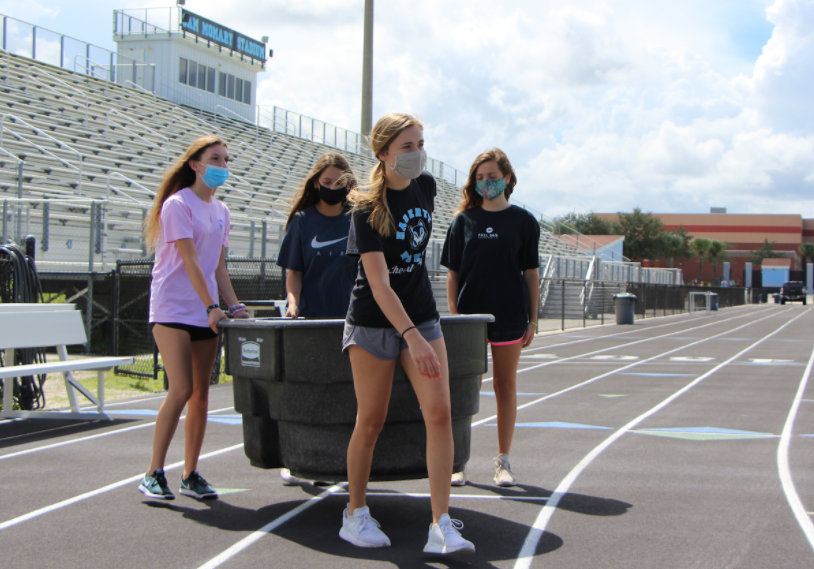As she dragged the cold-water immersion tub behind her, junior student athletic trainer Sophia Ramirez struggled across the football field, face mask shortening her breath. Behind her, fellow athletic trainer, senior Addison Smith, rolled a cart weighed down with 60 pounds of ice. Finally arriving at their destination, Ramirez started to fill the 150 gallon tub with water to prepare it for cold-water immersion.
Athletic trainers such as Ramirez have taken on new responsibilities since the Zachary Martin Act. After Zachary Martin died from heat exhaustion at Fort Myers Riverdale High School from running sprints in 2017, the FHSAA passed the Zachary Martin Act requring high schools to have cold-water immersion tubs on hand. In case any athletes start to show symptoms of heat exhaustion, the tubs cool down athletes’ core body temperature.Student athletic trainers learned to spot the signs of heat exhaustion, such as lack of sweating, throbbing, or glazed-over eyes. If they noticed something off, they would follow the “cool before transport” procedure; trainers would transport the players to the cold-water immersion tub and submerge them for 15 minutes before going to the hospital.
“I would feel a little stressed out if someone suffered from heat trauma, but it’s important to remain calm,” student trainer Ryleigh Mitchell said.
In the past, if a player exhibited signs of heat exhaustion, trainers removed them from practice and led them to the shade. If they still seemed disoriented, the player would be moved into a building with air conditioning and if they started to fall unconscious,they would go into the cold-water immersion tub.
“The Zachary Martin Act is better than what we have done in past years,” Miessau said. “The guidelines are much safer and they give strict rules and guidance instead of guess work for when decisions are made. We live in one of the most dangerous climates when heat is not properly checked.”
The Wet Bulb Globe Temperature heat stress gauge, or Wet bulb, was also added this year to ensure safety. It uses an algorithm to calculate the temperature for which heat trauma procedures are based on. A Wet bulb showing over 90 degrees Fahrenheit prevents football players from wearing pads; above 92 degrees Fahrenheit and no team can practice outside.
“I’ve been practicing in the heat for three years and it is a pain to stop practice multiple times to take off and put on our pads every couple minutes,” fullback Aramis Sattler said.
Rules for off-campus sports are different. While off-campus sports are required to have tarps on hand with 20 pounds of ice, they do not have trainers or cold-water immersion tubs nearby. Instead, coaches and players learn the “taco method” where teammates wrap the player experiencing heat exhaustion in a tarp with ice for 15 minutes.
“We took a heat illness course and I learned what to do when someone is experiencing heat exhaustion while we are running,” senior cross country runner Jacob Smith said. “I would be nervous for the person’s health but excited to try out the taco method.”
Trainers and students continue to cope with the heat as summer approaches its end. However, the Zachary Martin Act allows for little risk of heat trauma.
This story was originally published on Hagerty Journalism Today on September 16, 2020.































![IN THE SPOTLIGHT: Junior Zalie Mann performs “I Love to Cry at Weddings,” an ensemble piece from the fall musical Sweet Charity, to prospective students during the Fine Arts Showcase on Wednesday, Nov. 8. The showcase is a compilation of performances and demonstrations from each fine arts strand offered at McCallum. This show is put on so that prospective students can see if they are interested in joining an academy or major.
Sweet Charity originally ran the weekends of Sept. 28 and Oct. 8, but made a comeback for the Fine Arts Showcase.
“[Being at the front in the spotlight] is my favorite part of the whole dance, so I was super happy to be on stage performing and smiling at the audience,” Mann said.
Mann performed in both the musical theatre performance and dance excerpt “Ethereal,” a contemporary piece choreographed by the new dance director Terrance Carson, in the showcase. With also being a dance ambassador, Mann got to talk about what MAC dance is, her experience and answer any questions the aspiring arts majors and their parents may have.
Caption by Maya Tackett.](https://bestofsno.com/wp-content/uploads/2024/02/53321803427_47cd17fe70_o-1-1200x800.jpg)
![SPREADING THE JOY: Sophomore Chim Becker poses with sophomores Cozbi Sims and Lou Davidson while manning a table at the Hispanic Heritage treat day during lunch of Sept 28. Becker is a part of the students of color alliance, who put together the activity to raise money for their club.
“It [the stand] was really fun because McCallum has a lot of latino kids,” Becker said. “And I think it was nice that I could share the stuff that I usually just have at home with people who have never tried it before.”
Becker recognizes the importance of celebrating Hispanic heritage at Mac.
“I think its important to celebrate,” Becker said. “Because our culture is awesome and super cool, and everybody should be able to learn about other cultures of the world.”
Caption by JoJo Barnard.](https://bestofsno.com/wp-content/uploads/2024/01/53221601352_4127a81c41_o-1200x675.jpg)






